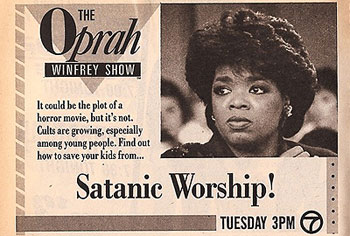Sleaze-O-Rama: Remembering the Halcyon Days of the Daytime Talk Show
Published on July 30th, 2011 in: Issues, My Dream Is On The Screen, TV, We Miss The Nineties |By Jesse Roth
The conclusion of Oprah‘s 25-year run on daytime television was heralded as the end of an era in several respects. Never again are we likely to see a media figure with as much power and widespread appeal as the mighty O. She was the figurehead of a special daytime ruling class, one that was seemingly overthrown by changing tastes long before she was willing to abdicate the throne. Despite her attempts to distance herself from her early years, enough people remember Oprah as a proud member (along with the likes of Geraldo Rivera and Morton Downey, Jr.) of the inaugural class of daytime sleaze, perverting a genre once owned by the legendary Phil Donahue. Though the daytime talk show genre is still kicking around the airwaves, its power and impact has been greatly reduced, crushed by the one-two punch of reality television and social media.

By the time I entered the daytime viewer fold in the mid-1990s, Oprah had long since cleaned up her act, while Donahue, Downey Jr., and Rivera had splintered off into various attempts at legitimate television careers. Though soap operas still littered the airwaves with their perfectly coiffed and diluted brand of drama, it was clear that daytime talk was king. Its perfect blend of real characters, relentless drama, and audience participation captivated even the most self-righteous television consumers. Whether you were a talk show devotee, or merely an innocent viewer/bystander, each day begat a treasure trove of shows dedicated to showcasing an overlooked segment of our diverse and ever-growing population: The lowest common denominator.
Like any great dramatic presentation, the proceedings were held on a stage, flanked by a moderately-sized and fairly ordinary-looking audience of onlookers, their reactions a mix of genuine shock and producer-coordinated outbursts. Each of the shows played to the personalities of their emcee (or lack thereof) while also making a concerted effort to recruit members of a particular socioeconomic stereotype and milk them for all they were worth. Legitimacy was given a cameo each show in the form of “expert” psychologists attempting to explain the crazy inhabiting the stage as well as the utilization of such technological innovations as the DNA test and the polygraph. Redemption came in the form of makeovers, surprise guests, and free trips to whatever rehab facility best suited the situation.
Preference for one show over another was a matter of which hosts you liked and which groups, when combined with a particular theme, produced the most compelling drama. After all, despite its reliance on repeating the same basic themes year in and year out, each daytime talk show did have its own distinct personality. Montel Williams attempted to be serious, moderating the contentious moments between suspected fathers, accusatory mothers, and cheating spouses with the same removed, authoritative delivery he used for chats with psychic Sylvia Browne. Maury Povich made everyone quickly forget he was the son of a prominent and well-respected sports journalist by creating both the official catch phrase of the paternity test (“You ARE the father!”) as well as the archetype of the unusually matched couple long before TLC turned the latter theme into its own reality show empire. Ricki Lake, herself a graduate of the John Waters Institute of Gloriously Manufactured Sleaze, was the perky, friendly talk show host-next-door that always felt comfortable chatting up (from a safe distance) the ghetto fabulous guests that frequented her stage. Jenny Jones’ mild personality was frequently overshadowed by her outlandish and tempestuous guests, while Sally Jessy Raphael attempted to be their stern, judgmental mother, quick to criticize but also ready to provide a temporary reprieve from their self-perpetuated dilemmas.

No matter who you loved most, everyone knows who was the true champion of 1990s daytime sleaze: Jerry Springer. Springer took the formulaic talk show format and injected it with black market steroids. His guests were always ready to brawl, causing the so-called “trailer trash” of the other shows to look downright refined in perspective. His audience participated via the familiar “Jerry! Jerry! Jerry!” chant, urging their ringmaster to both involve himself in, and mediate, the melee erupting on stage. The audience itself would occasionally get in on the action, barely discouraged by a security staff that sought out its own on camera roles with regularity.
On The Jerry Springer Show, the sluts were sluttier and the freaks freakier. Several stories even featured Springer participating in their worlds. One memorable instance occurred when Springer entered the recording booth with aspiring country singer Dori Schappell, who performed with her conjoined twin Lori (they are fused at the head). Though most saw the show as blatantly exploitative, Springer still managed to maintain an aura of genuine concern for, and fascination with, his guests. He never came off as a bully or a jerk despite instigating disputes with both his line of questioning and juxtaposition of guests.
Springer’s “civility amongst chaos” theme was laid out for the viewer at the end of each episode via his legendary “Final Thought,” a brief editorial by the host that halfheartedly attempted to provide perspective on the ridiculous scenarios thrown at the viewer for the preceding 58 minutes of the show. No matter the theme or guest, an episode of The Jerry Springer Show was always a guaranteed hour of entertainment at a time of the day when the television lineup tended to be rather barren.
Pages: 1 2
Time limit is exhausted. Please reload the CAPTCHA.